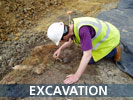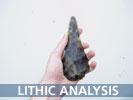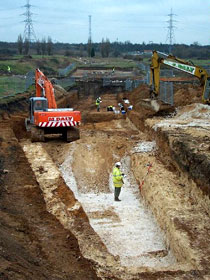|
CTRL Baker's Hole, Ebbsfleet Valley, Northfleet A major programme of fieldwork is being carried out at the site by Oxford Archaeology in advance of the construction of the Channel Tunnel Rail Link, funded by Union Railways Ltd (North). Although many significant Pleistocene deposits containing Palaeolithic evidence have been removed by previous quarrying, research for my PhD in the early 1990s and field evaluation in 1997 and 2001 showed that the route of the CTRL and the footprint of the new Ebbsfleet International Station impact upon surviving patches of Pleistocene sediments, and that these sediments contain occasional biological evidence and Levalloisian remains. Therefore a programme of mitigating works was commissioned to ensure that this evidence was properly investigated in advance of construction. One of the key points to bear in mind in the Ebbsfleet Valley is that it, or "Bakers Hole", is not a single Palaeolithic site, but an area filled with a complex suite of Pleistocene deposits that have produced different Palaeolithic evidence at various different locations, investigated at different times from the 1880s to the present day. The early finds were poorly recorded, if at all, and it has only been possible to estimate their locations and stratigraphic context by assiduous archival investigations and reference to the sequence of OS surveys fortunately carried out at regular intervals in the late 19th and early 20th centuries — 1865, 1895, 1907 and 1938. The earliest find from the site were by FCJ Spurrell in a tramway cutting in the 1880s, and then a major recovery of Levalloisian material by RA Smith of the British Museum took place in c. 1910, following identification of an artefact-rich location by a local collector J Cross. The objectives of the Palaeolithic
mitigating works include:
The results include the discovery of a variety of geological deposits rich in biological evidence, whose analysis should allow a far more complete understanding of the Pleistocene landscape history. Remnants were also discovered of the artefact-bearing deposits investigated by Smith and Spurrell, as well as the actual tramway route recorded by Spurrell in his pioneering work. However only a few Levalloisian artefacts were recovered, probably representing the tail end of a spread of artefacts caught up in chalk solifluction deposits originating from the spur of Chalk quarried away as New Barn pit, and investigated closer to their source by Smith and Cross. Acknowledgements References Spurrell, F.C.J. 1883. Palaeolithic implements found in West Kent. Archaeologia Cantiana 15: 89–103. Wenban-Smith, F.F. 1995. The Ebbsfleet Valley, Northfleet (Baker's Hole). In (D.R Bridgland, P. Allen & B.A. Haggart, ed's) The Quaternary of the Lower Reaches of the Thames: Field Guide: 147–164. Quaternary Research Association, Durham. Wenban-Smith, F.F. 1990. The location of Baker's Hole. Proceedings of the Prehistoric Society 56: 11–14. Wenban-Smith, F.F. 2001. LSS excursion to Baker's Hole, Kent. Lithics 22: 55–57. |
|
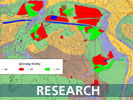 |
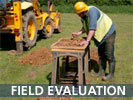 |
 |
 |
